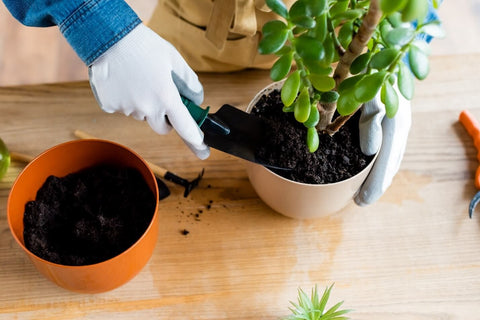To keep your plants healthy, they need to be watered regularly. However, too much watering can cause problems for your plants. It’s important to know how much water your plants need to help prevent overwatering. Check out a few signs that you’re overwatering your plants.
What Happens When You Overwater Plants?

When plants receive too much water or the soil drains poorly, the soil can become waterlogged. This creates a problem for roots because it hinders their ability to absorb the oxygen they need, causing them to suffocate or die. Dying, decaying roots can’t supply the plants with the necessary nutrients and water. Plants stressed or injured from overwatering can also be more susceptible to illness and bugs.

Signs You’re Overwatering Your Plants

If your plants are receiving too much water, changes in their appearance can help you identify the problem. We’ve made a list of signs that warn of overwatered plants.
- Stunted Plant Growth: If plants are being overwatered, it can cause stunted plant growth. Your plants won’t be able to receive the nutrients they need to support growth, causing plants to grow slowly or to stop growing.
- Yellowing Leaves: Yellowing leaves can be an indicator of overwatering. This can also be a sign of underwatering your plants. If the soil is wet and the leaves aren’t dry, then overwatering is likely the cause.
- Leaf Scorch: Leaf scorch causes browning on leaves and is often caused by a lack of moisture. When plants are overwatered, the roots struggle to actually absorb the water. Leaves won’t receive the moisture they need, leading to leaf scorch.
- Water Spots & Blisters: Overwatering can cause water-soaked patches or blisters on leaves. This is often referred to as Oedema. Patches will start on the underside of leaves and can turn into warty swellings.
- Crown Rot: Crown rot is a disease caused by a soil-borne fungus. It often develops from excess moisture in the soil. Overwatering your plants can cause suitable conditions for this disease to develop. The stems of plants will rot and leaves will turn brown.
How to Avoid Overwatering Your Plants

Finding a balance between too much or too little water is important. Check out a few tips to help avoid overwatering your plants.
- Know the Needs of Your Plants: Before bringing home a new plant, make sure you know its needs. Each plant will require different amounts of water, so read and follow the care instructions. Choose plants that work well in your climate.
- Ensure Proper Drainage: Choose pots that have drainage holes to decrease excess moisture. Use well-draining soil so water doesn’t accumulate near the roots.
- Check the Soil: Before watering, check the soil to see if it’s wet or dry. Typically, you only need to water your plants if the top inch or two inches of soil is dry.
- Check the Weather: Pay attention to the weather. In seasons of dry and hot conditions, your plants may need to be watered more frequently. During wet seasons, you won’t need to water your plants as often.
- Water Deep into the Soil: You want to make sure water gets deep into the soil. To do this, water for longer periods of time but less frequently. Water at the base of the plants instead of applying water to the leaves. This will prevent moisture build-up on the leaves, which can help to prevent fungal diseases.
How to Save Overwatered Plants

If your plants are struggling from overwatering, you can take steps to help them recover. We’ve made a list of tips to help save your overwatered plants.
- Stop Watering Your Plant: Though it seems simple, the best thing you can do is stop watering your plant. This will give the soil a chance to dry out, which will help your plant to recover.
- Move Your Plant: You’ll want to move your plant to a shadier spot. Waterlogged roots aren’t able to absorb the water your plant needs to survive. Your plant won’t need as much water if it isn’t in a sunny location.
- Check the Drainage: Make sure your pots or soil has proper drainage. You may need to switch your potting soil if it’s not allowing water to drain. You can also carefully poke holes in the soil to help break up compacted soil.
- Repot the Plant: If possible, you can move your plant to a new pot. Make sure to use fresh, clean soil.
- Give it Time: Your plants will need a little time to recover. You should be able to tell if they’re doing better within a week of making the necessary changes.
- Be on the Lookout for Fungal Diseases: Fungal diseases can thrive in moist conditions, so you’ll want to check for signs of these diseases. You can treat your plants with a plant-based insecticide spray, like our 3-in-1 Garden Spray, to help to control and prevent fungal diseases, insects, and mites.
Keeping your plants healthy means ensuring they receive the right amount of water. Knowing what to look for can help you prevent overwatering, which will help to protect your plants from diseases and pests. If your plants are under attack, we’re here to help! For a more environmentally and family-friendly solution, check out our garden products.

Thanks! Great info. Couldn’t understand what my yellow leaves were from. Now, I know!